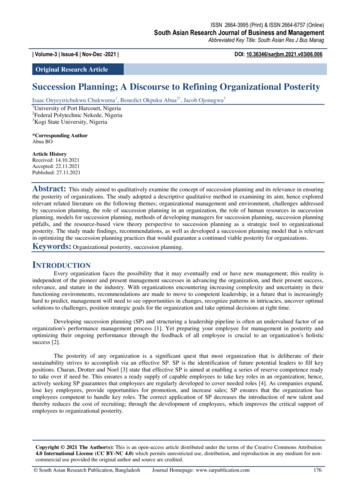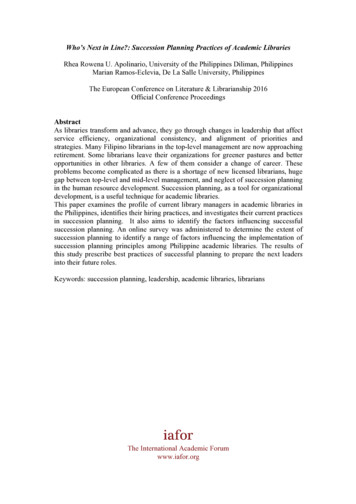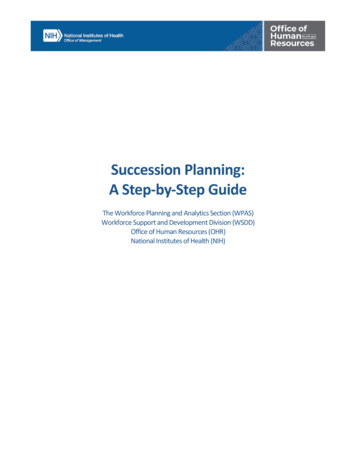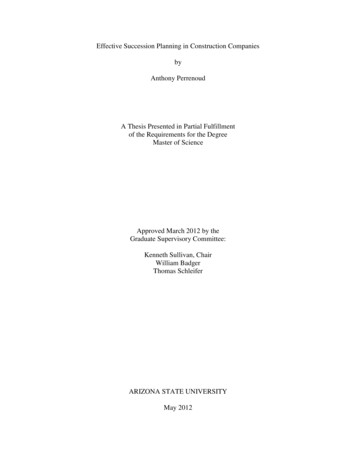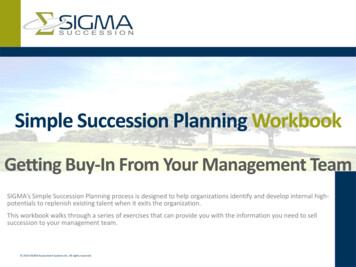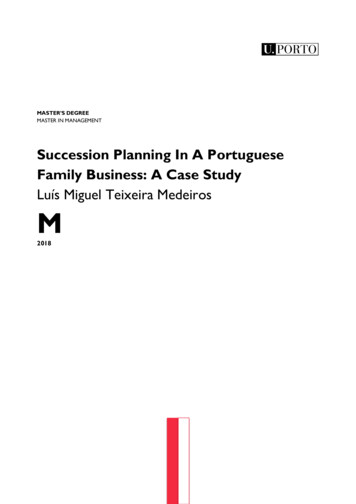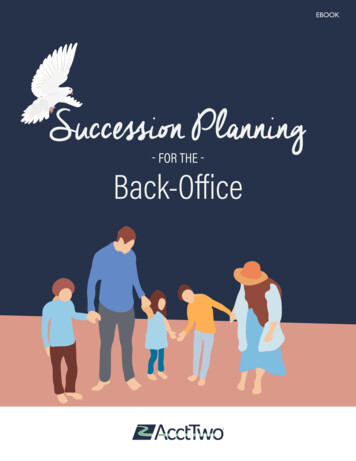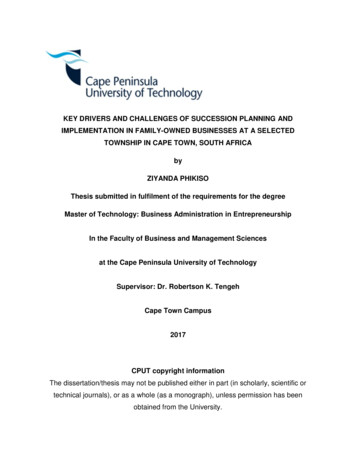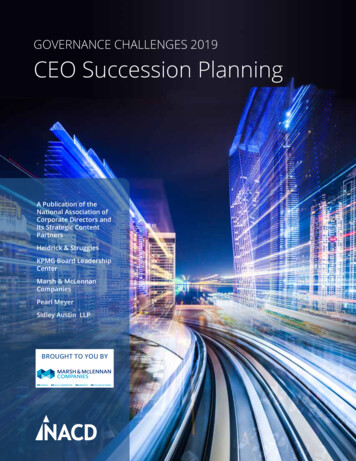
Transcription
GOVERNANCE CHALLENGES 2019CEO Succession PlanningA Publication of theNational Association ofCorporate Directors andIts Strategic ContentPartnersHeidrick & StrugglesKPMG Board LeadershipCenterMarsh & McLennanCompaniesPearl MeyerSidley Austin LLPBROUGHT TO YOU BY
The CEO as ‘Culture Champion’By David H. Jackson, PhD, Partner, MercerOverseeing CEO succession is one of the centralstrategic and fiduciary roles of the board of directors.How the role of the CEO plays as the “Chief CultureOfficer” of the organization must be a criticalconsideration for the board as they undertake CEOsuccession and transition planning activities.The CEO influences culture to such a degreethat she or he may be thought of as the key factorthat determines the culture of a corporation. In aworkforce context, culture is about behaviors thatdeliver business outcomes and how operational driversare leveraged to reinforce those behaviors across theworkforce. (See Sidebar: Organizational Culture Defined)As the ultimate “culture champion,” theCEO drives the employer brand so that her or hisorganization prevails in the talent wars, and, overtime, builds a workforce and working environment inwhich people are not only engaged but thriving, bothtoday and in the future.With guidance and accountability by the board,the CEO is the ultimate owner of culture alignment,and it is therefore essential that cultural factors areconsidered in CEO succession and transition. As notedin a report by Marsh & McLennan,1 the board’s maininstrument by which they can influence culture isthrough the selection of the CEO, and in turn, the teamthe CEO develops.Indeed, as recommended by a recent NACD BlueRibbon Commission, “directors should make culturean explicit criterion in the selection and evaluationof the CEO and set the expectation that the CEO andsenior leaders do the same in their identification andsuccession planning activities.” 2CULTURE IS CRITICAL TO ORGANIZATIONALSUCCESS AND A RISK FACTOR IN STRATEGYEXECUTIONAn organization’s culture is recognized as vitalfor success and differentiation and can be viewed asthe “rocket fuel” for delivering value to stakeholders.3Successful businesses show time and again thatpossessing the right culture that enables employeesto thrive can prove to be a source of competitiveadvantage. One study found that companies withORGANIZATIONAL CULTURE DEFINEDOrganizational culture can be defined as theorganization’s shared and experienced values, beliefs,and behaviors. Pragmatically, it can be understood as theorganization’s operating environment. It is what peoplesay and what people do, day-in, day-out, and it is revealedin individual actions that deliver business outcomes,and also in an organization’s norms, working language,systems, and symbols. From a business context, cultureshould align with the strategy of the organization aswell as with market and regulatory factors. From anorganizational context, culture is reflected in policy andprocedures, and every level of the governance structureshould buy into and live the culture. From a peoplecontext, the culture enables people to do their jobs,supporting talent acquisition and team effectiveness.WomenCorporateDirectors and Marsh & McLennan Companies, Identifying and Responding to a Dysfunctional Culture – KeyActions for Boards, 2019.² National Association of Corporate Directors, Report of the NACD Blue Ribbon Commission on Culture as a Corporate Asset(Washington, DC: NACD, 2017), p. 20.³ Ibid., p. 7.1CEO Succession Planning15
practices that established them as “talent managementmaturity leaders” outscored peer companies on 18different performance measures, and in some casesby triple-digit percentage margins. Specifically,they showed 54 percent greater net profit marginand 18 percent better earnings before interest, taxes,depreciation and amortization (EBITDA).4For example, consider the criticality of culturealignment to the success of merger and acquisition(M&A) transactions, which so often represent thebiggest capital and branding bets a CEO undertakes.Recent Mercer research found that 43 percent ofM&A transactions worldwide experienced seriouscultural misalignment, causing deals to be delayedor terminated, or negatively affecting the purchaseprice.5 In the same study, culture issues were cited asthe reason 67 percent of M&A transactions experienceddelayed synergy realization. Leaders also noted that30 percent of deals fail to ever achieve financialtargets due to cultural misalignment and subsequentproblems, such as productivity loss, the flight of keytalent, and customer disruption.WHY IS CULTURE ON THE BOARD AGENDA?Boards of directors have a responsibility to bring rigorto cultural oversight. It is generally recognized that theboard is responsible, alongside management, for settingthe “tone at the top” and overseeing management’sstrategy to promote a culture that aligns with theorganization’s overall strategy. Indeed, the 2018 UKCorporate Governance Code puts a renewed emphasison calling on boards to assess and monitor culture. 6There is also a rising board focus on culture andhow the organization operates and achieves its goals.Three trends are driving this:1. Increased focus on environmental, social,and governance factors (ESG) by stakeholdersand investors that includes an emphasis onunderstanding how organizations treat theiremployees. Investors are also paying greater⁴5678attention to culture-related performance metrics.2. Acceleration of social activism (e.g., the #MeToomovement) has pushed cultural issues to theforefront of directors’ minds and has reinforcedto board members that they can no longer afford areactive approach to monitoring culture.3. The amplifying effects of social media and websitesthat include company reviews by employees (suchas Vault and Glassdoor), or customer review sites(such as Yelp), have made organizational culturesincreasingly transparent to outsiders. The speedwith which information spreads, enabled by socialmedia technologies, has changed the time line oftraditional corporate communication processes.THE CEO AS ‘CULTURE CHAMPION’Despite the important role of organizational cultureand of the CEO as the “Chief Culture Officer,”research suggests that in many instances culturalelements are not formally or clearly embedded in theCEO succession and transition process. For example,survey data suggest that over the past 12 months,nearly 40 percent of boards have formally evaluatedthe CEO as a leader of organizational culture but just22 percent have assessed executive candidates forcultural/values fit. However, while assessment forcultural fit is important when reviewing internal andexternal CEO candidates, according to NACD only 13percent of boards have used an assessment survey toreview the candidates’ “fit as part of their successionplanning.”7Poorly managed CEO succession and transitionplans pose a serious threat to business performanceand, ultimately, to shareholder value.8 When a CEOtransition goes awry, the collateral damage canbe enormous—creating a leadership vacuum, thedefection of quality talent, increased internal andexternal uncertainty, interruptions in normal decisionmaking and business processes, and the loss ofshareholder and stakeholder confidence.The Hackett Group, Talent Management Performance Study, 2009.Mercer, Mitigating Culture Risk to Drive Deal Value, 2018.Jessica Fino, “Business world reacts to new Corporate Governance Code,” Economia, July 16, 2018.National Association of Corporate Directors, 2018–2019 NACD Public Company Governance Survey (Arlington, VA: NACD, 2018), p. 70.Mercer, CEO Succession Planning That Works, 2012.162019 Governance Challenges
GETTING STARTEDHow should the board approach the all-importantrole of CEO succession and transition and ensure thatcritical considerations about culture are part of theprocess? Below are a series of specific concrete stepsdirectors can take. (See Exhibit 1.)1. Determine the desired culture that will catalyzebusiness results as defined by the business strategy,and ensure effective competition for talentrecruitment and retention. The board—via the executive, nominating andgovernance, or compensation/human resources(HR) committee—works with the CEO and thechief human resource officer (CHRO) to select acultural definition and assessment tool. The kickoff should start with a workshopwith the board and senior management, oftenexternally facilitated by culture/organizationaldesign experts, to define the desired culturegiven the business strategy, evolving businessmodel, and workforce and leadership talentrequirements. The compensation/HR committee members,along with the CHRO, compare the desiredculture to established skill and competencyprofiles for the CEO and his/her executiveleadership team to ensure the two frameworksmeaningfully sync up (i.e., that expected CEObehaviors and areas of acumen will support thedelivery of the desired culture). For example,if collaboration is a key characteristic of thedesired culture, then the CEO’s leadershipprofile should explicitly include collaborationas a behavioral expectation, as a criterion forCEO selection, and as part of the ongoing annualboard evaluation of the CEO.2. Assess the incumbent’s fit with the desired culture. Identify the specific behaviors explicitly insync with driving the desired culture. Then,the compensation/HR committee shouldEXHIBIT 1Key Steps In Incorporating Culture Into CEO Succession PlanningTRACK & SUPPORT CEO WITH CULTURECHAMPIONSHIP Track and discuss as an ongoing boardagenda item Embed culture leadership into CEO’sannual evaluation CEO and CHRO share results ofemployee engagement/culturesurveys with board4APPLY CULTURE CRITERIA TOSUCCESSION PLANNING Share statement of desiredculture with candidates for CEO’srole and search firm Use behavioral event interviewmethodology with candidates Incorporate expected outcomes of culturechampionship into annual goals, and measure andreward accordingly1ROLEOF THEBOARD32Source: MercerDETERMINE DESIRED CULTURE Define culture Select assessment tool Compare CEO andexecutive leadership againstcompetency profile alignedwith desired cultureASSESS INCUMBENT’S FIT Identify behaviors requiredto drive desired culture andcommunicate expectations to CEO Annually evaluate CEO with360-assessment and interviewswith senior management and theboard Conduct periodic workforcesurveysCEO Succession Planning17
communicate the board’s expectations tothe CEO as the foundation for subsequentperformance evaluations. The board shouldemphasize the critical importance of the CEOacting as a driver and champion of the desiredculture. Annual evaluations of the CEO will revealthe success of the CEO as culture leader andchampion, and this should be part of her/hisannual feedback. This is most effectively donevia an online 360-degree assessment of theCEO’s performance that includes the following:{{Views of directors and members ofmanagement. The recommended, empirical,candid mechanism for gathering feedbackis the 360-degree review. Interviews withdirectors and senior management, informedby the 360 findings, will yield actionableinsights, and culture should be explicitlyreferenced in the interviews.{{Views of the workforce. This can be done witha culture or employee-engagement surveythat includes questions about the degree towhich the desired culture is manifested intheir day-to-day experience as employees. Feedback on the CEO’s performance related tosupporting and championing the desired cultureshould be shared in the review process andshould influence rewards.3. Apply the definition of culture, assessmentdiscipline, and associated tools when planning forand executing a CEO succession. Document a statement of the desired culturethat can be shared with internal and externalCEO candidates, and with executive searchfirms. Ensure that the statement, along with theprofile of prospective CEO behaviors that theboard believes will drive and sustain the desiredculture, is used throughout the successionprocess, including performance assessmentand leadership-development discussions by theboard about in-house candidates (facilitated bythe CHRO and/or external experts as needed). Usebehavioral event interviewing (BEI)methodology with internal and externalcandidates to ensure that conversations areconcrete and specific.9 Incorporate the definition and expectedoutcomes of effective cultural championshipinto the annual goals for the incoming CEO, toensure that cultural considerations are reflectedin performance assessment, measurement, andrewards as described in #2 on the previous page.4. Support the new CEO as he or she carries out thecritical responsibility of culture championship. Make culture—including how to steward, trackand demonstrate it—an ongoing agenda item inboard meetings. Engage the CEO and CHRO inthese discussions. Weave measurement of cultural championship,using the CEO leadership profile, into theannual CEO evaluation and make it a part ofcompensation discussions and decisions. If theboard believes that the CEO’s leadership style isgetting in the way of his or her ability to deliverthe desired culture, the board should considerapproaches such as retaining an executive coachfor development purposes. Request regular reports from the CEO and CHROon the results of employee engagement/culturesurveys.The job of CEO has always been challenging, andadding a cultural dimension to the CEO’s responsibilitiescould be seen as too subjective, too hard to measure, ortoo difficult to incorporate into succession-planningprocesses. But society and organizations today are sodynamic, fast-changing, and stakeholder-driven that ahigher degree of cultural rigor is now required for CEOsand boards alike—and a CEO with the right cultural fitcan make a transformative difference to an organization’sperformance over time. When boards ensure their C-suite,leadership bench, and CEO transitions consistentlysupport the organization’s desired culture, they will helpenergize the entire workforce to deliver business resultsboth today and in the future.See Libby Anderson’s article, “Using Behavioral Interviewing Techniques to Select the Right Employees,” July 20, 2008, on theSociety for Human Resource Management’s website.9182019 Governance Challenges
1515 N. Courthouse Road, Suite 1200Arlington VA 22201NACDonline.org
Overseeing CEO succession is one of the central strategic and fiduciary roles of the board of directors. How the role of the CEO plays as the "Chief Culture Officer" of the organization must be a critical consideration for the board as they undertake CEO succession and transition planning activities. The CEO influences culture to such a degree
